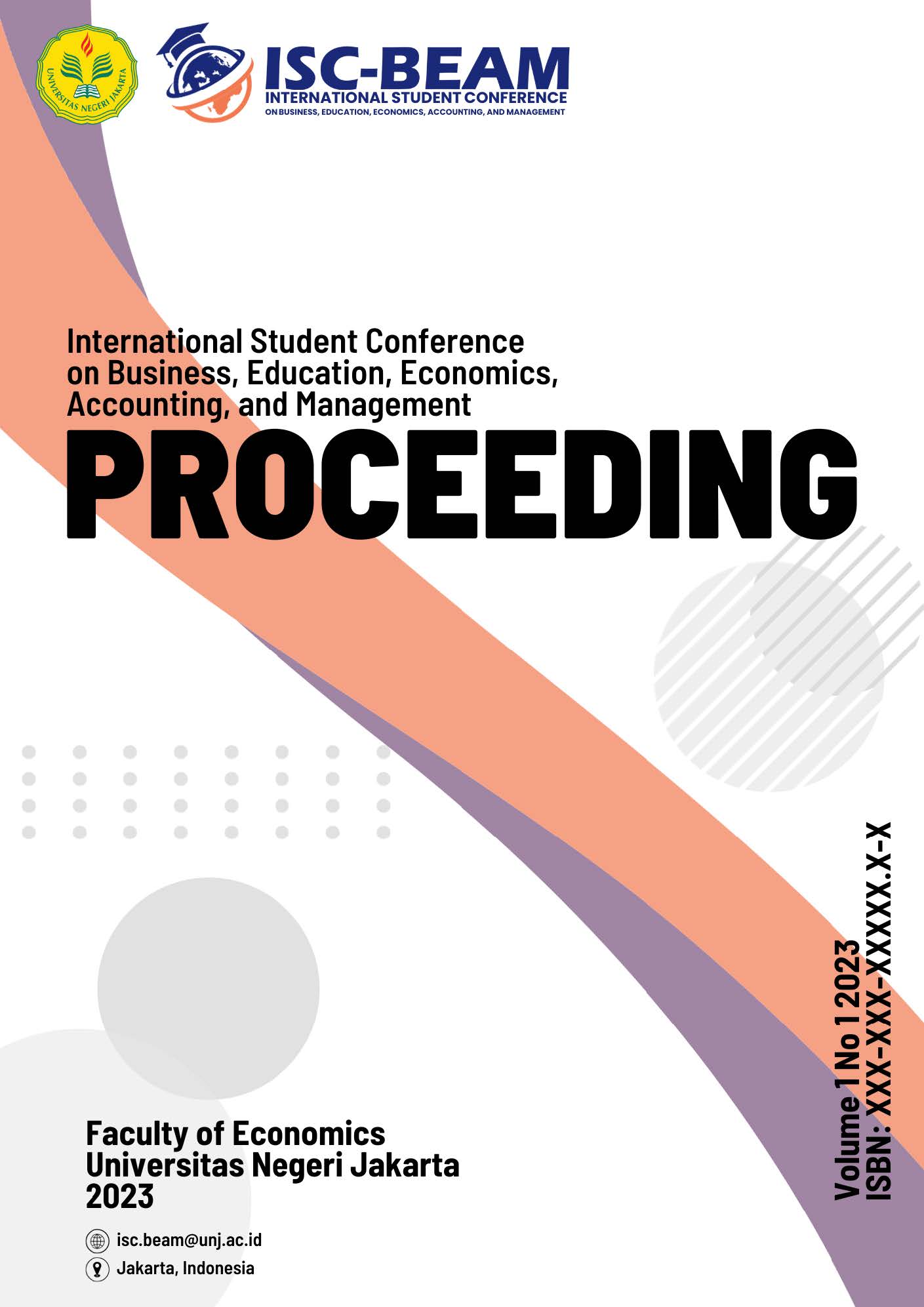AN Analysis of Factors Affecting Employee Engagement in Startup Companies (Traveloka, Tiket.com and Pegipegi)
DOI:
https://doi.org/10.21009/ISC-BEAM.011.41Keywords:
Employee Engagement, Ethical Leadership, Self-Efficacy, Work ClimateAbstract
This research aims to observe human resource management policies to form employee engagement, especially in the millennial generation. The time for conducting this research is April to November 2023. This research uses a quantitative approach using non-probability sampling and purposive sampling techniques. Overall, 210 data were obtained with the criteria being that the respondents were permanent employees, had worked for three years and worked in a startup company. The data analysis technique used in this research is Structural Equation Modeling (SEM) using SMARTPLS. The results of this research state that five direct hypotheses and two indirect hypotheses are accepted
References
Bakker, A. B., Albrecht, S. L., & Leiter, M. P. (2011). Work engagement: Further reflections on the state of play. European Journal of Work and Organizational Psychology, 20(1), 74–88.
Balwant, P. T., Mohammed, R., & Singh, R. (2020). Transformational leadership and employee engagement in Trinidad’s service sector: The role of job resources. International Journal of Emerging Markets, 15(4), 691–715. https://doi.org/10.1108/IJOEM-01-2019-0026
Bandura, A. (2006). Guide for constructing self-efficacy scales. Self-Efficacy Beliefs of Adolescents, 5(1), 307–337.Bhana, A. (2019). The impact of ethical leadership on employee engagement within a South African public higher education institution. Problems and Perspectives in Management, 17(4).
Brown, M. E., & Treviño, L. K. (2006). Ethical leadership: A review and future directions. Leadership Quarterly, 17(6), 595–616. https://doi.org/10.1016/j.leaqua.2006.10.004
Brown, M. E., Treviño, L. K., & Harrison, D. A. (2005). Ethical leadership: A social learning perspective for construct development and testing. Organizational Behavior and Human Decision Processes, 97(2), 117–134.
Clifton, -Jim. (2016). “We change the world one client at a time through extraordinary analytics and advice on everything important facing humankind.”www.gallup.com/contact.
Geue, P. E. (2018). Positive practices in the workplace: Impact on team climate, work engagement, and task performance. The Journal of Applied Behavioral Science, 54(3), 272–301.
Hair, J. F., Matthews, L. M., Matthews, R. L., & Sarstedt, M. (2017). PLS-SEM or CB-SEM: updated guidelines on which method to use “PLS-SEM or CB-SEM: updated guidelines on which method to use.” In Organizational Research Methods, MIS Quarterly, and International Journal(Vol. 1, Issue 2).
Hair Jr, J. F., Hult, G. T. M., Ringle, C. M., Sarstedt, M., Danks, N. P., & Ray, S. (2021). Partial least squares structural equation modeling (PLS-SEM) using R: A workbook. Springer Nature.
Inc, G. (2022). State of the Global Workplace: 2022 Report.
Jaafari, P., & Soleimani, N. (2012). The relationship among organizational climate, organizational learning and teachers’ self efficacy. Procedia-Social and Behavioral Sciences, 47, 2212–2218.
Kahn, W. A. (1990). Psychological Conditions of Personal Engagement and Disengagement at Work. In Academy of Management Journal(Vol. 33, Issue 4).
Karantzas, G. C., McCabe, M. P., Mellor, D., Von Treuer, K., Davison, T. E., O’Connor, D., Haselden, R., & Konis, A. (2016). Organizational climate and self-efficacy as predictors of staff strain in caring for dementia residents: A mediation model. Archives of Gerontology and Geriatrics, 66, 89–94.
Kirby, J. R., Delva, M. D., Knapper, C., & Birtwhistle, R. V. (2003). Development of the approaches to work and workplace climate questionnaires for physicians. Evaluation & the Health Professions, 26(1), 104–121.
Langlois, L., Lapointe, C., Valois, P., & de Leeuw, A. (2014). Development and validity of the ethical leadership questionnaire. Journal of Educational Administration, 52(3), 310–331.
Meeusen, V. C. H., Karen Van Dam, M. A., Brown-Mahoney, C., Van Zundert, A. A. J., & Knape, H. T. A. (2011). Work Climate Related to Job Satisfaction Among Dutch Nurse Anesthetists. In AANA Journal(Vol. 79, Issue 1). www.aana.com/aanajournalonline.aspx
Naeem, R. M., Weng, Q., Hameed, Z., & Rasheed, M. I. (2020). Ethical leadership and work engagement: A moderated mediation model. Ethics & Behavior, 30(1), 63–82.
Orgambídez, A., Borrego, Y., & Vázquez‐Aguado, O. (2019). Self‐efficacy and organizational commitment among Spanish nurses: the role of work engagement. International Nursing Review, 66(3), 381–388.
Parimita, W., Pambudi, W. S., & Aminah, H. (2017). The Impact of Career Development and Workload Toward Employee Job Satisfaction At PT Askrindo Jakarta. JRMSI-Jurnal Riset Manajemen Sains Indonesia, 8(1), 39–57.
Pati, S. P., & Kumar, P. (2010). Employee engagement: Role of self-efficacy, organizational support & supervisor support. Indian Journal of Industrial Relations, 126–137.
Ram, P., Swapna, B. G., & Prabhakar, G. V. (2011). Work environment, service climate, and customer satisfaction: Examining theoretical and empirical connections. International Journal of Business and Social Science, 2(20).
Ren, S., & Chadee, D. (2017). Ethical leadership, self-efficacy and job satisfaction in China: the moderating role of guanxi. Personnel Review, 46(2), 371–388.
Santrock, J. W. (2007). A topical approach to life-span development, 3E. Ch, 5, 192.
Schaufeli, W. B., Bakker, A. B., & Salanova, M. (2006). The measurement of work engagement with a short questionnaire: A cross-national study. Educational and Psychological Measurement, 66(4), 701–716. https://doi.org/10.1177/0013164405282471
Schneider, B., Ehrhart, M. G., & MacEy, W. H. (2013). Organizational climate and culture. In Annual Review of Psychology (Vol. 64, pp. 361–388). Annual Reviews Inc. https://doi.org/10.1146/annurev-psych-113011-143809
Sekaran, U., & Bougie, R. (2017). Metode Penelitian Untuk Bisnis: Pendekatan Pengembangan Keahlian Edisi 6 Buku 1.
Tsaur, S. H., Hsu, F. S., & Lin, H. (2019). Workplace fun and work engagement in tourism and hospitality: The role of psychological capital. International Journal of Hospitality Management, 81, 131–140. https://doi.org/10.1016/j.ijhm.2019.03.016
Walumbwa, F. O., Mayer, D. M., Wang, P., Wang, H., Workman, K., & Christensen, A. L. (2011). Linking ethical leadership to employee performance: The roles of leader–member exchange, self-efficacy, and organizational identification. Organizational Behavior and Human Decision Processes, 115(2), 204–213.






